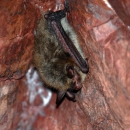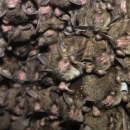These are FAQs for previous versions of the Range-wide Indiana Bat and Northern Long-eared Bat Survey Guidelines.
Current guidelines are available at: https://www.fws.gov/media/range-wide-indiana-bat-and-northern-long-eared-bat-survey-guidelines
The Indiana bat (Myotis sodalis) was originally listed as being in danger of extinction under the Endangered Species Preservation Act of 1966 (32 FR 4001, March 11, 1967), and is currently listed as endangered under the Endangered Species Act (ESA) of 1973, as amended. This survey protocol provides the U.S. Fish and Wildlife Service’s (USFWS) recommended guidance on survey methods and outlines additional reporting requirements for surveyors for Indiana bat and Northern Long-eared Bat.






